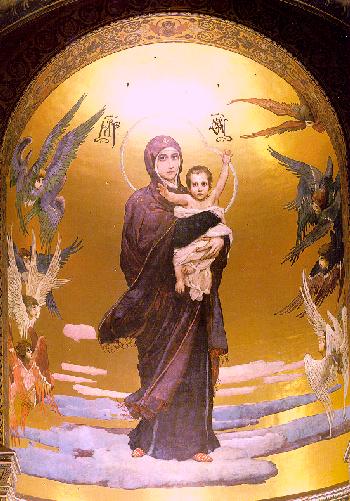
Mural in the apse of the Cathedral of St. Vladimir, Kiev.

 Vasnetsov's The Mother of God with the Infant Christ is an
intriguing work of the artist and a representative sample of the developing
19th century Russian art. Although since Peter the Great's time Russia
had been heavily influenced by the West, a graceful synthesis of iconographic
traditions and modern technique had not been achieved until Vasnetsov.
This is perhaps nowhere more evident than in this painting; its careful
examination will reveal both Vasnetsov's individual style and the techniques
he uses to fuse two seemingly diverse ideas.
Vasnetsov's The Mother of God with the Infant Christ is an
intriguing work of the artist and a representative sample of the developing
19th century Russian art. Although since Peter the Great's time Russia
had been heavily influenced by the West, a graceful synthesis of iconographic
traditions and modern technique had not been achieved until Vasnetsov.
This is perhaps nowhere more evident than in this painting; its careful
examination will reveal both Vasnetsov's individual style and the techniques
he uses to fuse two seemingly diverse ideas.
First, it should be noted that this painting follows the basic compositional elements of an icon representing the Virgin and child (i.e. the Virgin heavily draped in clothing, Jesus swaddled in white cloth, the halos, and the angels flying around). Compared with earlier icons, however, this representation is much more life-like. The picture is clearly three-dimensional in perspective and maintains a high level of fidelity to 'realistic' detail (folds and highlight / shadow areas of clothing). The slightly eerie-looking angels are also very life-like, and give the impression that somewhere in this world they do indeed exist. The movement apparent both in the angels and the child , though not unknown in earlier Russian icons, reaches a new high here and may reflect the influence of the European baroque painting.
A second point of comparison is the level of austerity, or lack thereof, in this painting. Russian icons, particularly those heavily influenced by Byzantine examples, tend to be rather disquieting and sometimes even fearsome representations of the other-worldly figures. As Russian icon painting developed, however, the representations became more tender and less severe but not, I believe, quite as free and "light" as the figures in this scene. The movement of the angels appears to be spontaneous and free; the Virgin's clothes are being blown by the wind, even the clouds and the luminosity of the background indicate a transience that is just balanced by a feeling of eternal peace and goodwill. The very fact that all these details draw one's attention to nature also emphasizes freedom and God's living presence within his creation.
These "secondary" considerations are important to creating mood and atmosphere, but are perhaps subordinate to the expressions of Mary and baby Jesus. The Virgin's face reflects a calm and determined spirit, while the baby is active and eager to begin his work on the earth. One could even say that Jesus' arms here are welcoming, ready to embrace the world with both His love and His peace. This is distinctly different from the more "placid" baby Jesus typical of icons. His eyes are even bright and seem to be intelligent; Vasnetsov has expressed this both through their size and intensity. Mary's eyes are also large and intense, but this was achieved more in the old style of icon painting. Large, dark, and almond shaped, Mary's eyes are perhaps one of the most "mystical" aspects of the painting.
The painting is also compositionally effective. The angels create a graceful and geometrically dynamic frame; the clouds below Mary's feet are both realistic and "heavenly;" the golden background not only draws our attention to Mary and the baby Jesus, it also characterizes their presence as good and as representative of the "light" God shed on mankind through His Son and the Holy Spirit.
Altogether, the The Mother of God with the Infant Christ is successful both as a 19th century iconic representation and as an impressive example of the art of the Russian Revival. Though it differs from both the traditional icons and the norm of 19th century Russian art, it is able to unite ideas and techniques from both fields. Rosa Newmarch asserts that it is "the boldest and most distinctly national of all [Vasnetsov's] pictures;" at least it is clear that it is an "inspired" painting that "lights[s] a little candle to the glory of God." [C.B.]
[Source: Newmarch].
